Market Overview
The Global Intermediate Bulk Container Liner Market size is projected to reach USD 1.3 billion in 2025 and grow at a compound annual growth rate of 6.1% from there until 2034 to reach a value of USD 2.2 billion.
An Intermediate Bulk Container (IBC) liner is a protective, flexible inner layer used inside rigid IBCs to safely store and transport liquids, powders, or granules. These liners act as a barrier between the product and the container, ensuring contamination-free handling and extending the life of the container. They are especially useful for food, chemicals, pharmaceuticals, and other sensitive materials. Liners are made from materials like polyethylene or foil laminates, and they come in different forms such as form-fit, pillow-shaped, or aseptic designs.
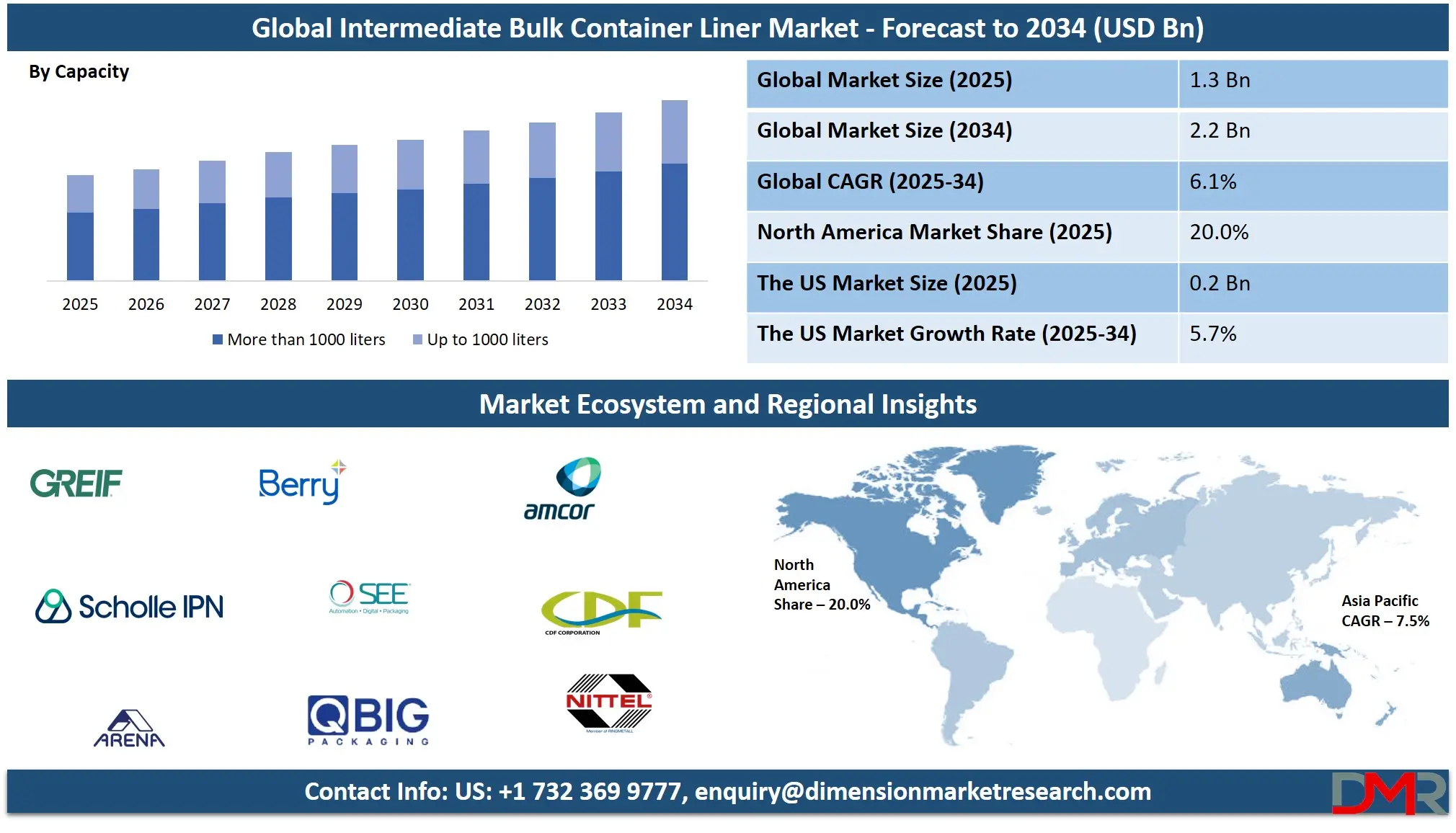
In recent years, demand for IBC liners has grown due to the increasing focus on hygiene and safety in bulk packaging. Industries are shifting toward flexible, cost-effective, and eco-friendly packaging solutions. IBC liners eliminate the need for cleaning containers after each use, reducing labor, water, and chemical usage. As global industries grow, especially food processing, agriculture, chemicals, and pharmaceuticals, the need for safe, efficient bulk transportation has risen, boosting demand for liners.
A major trend driving adoption is sustainability. IBC liners support circular packaging goals by enabling the reuse of containers while replacing only the inner liner. This reduces waste and improves operational efficiency. Additionally, manufacturers are developing liners using recyclable and biodegradable materials. Innovations also include multi-layered liners for better protection and longer shelf life, which are particularly helpful for perishable or hazardous materials.
Automation and clean-room compatibility have also influenced liner development. Many facilities now prefer pre-sterilized liners that can be installed quickly in sterile environments. Aseptic liners are being increasingly used in pharmaceutical and biotechnology sectors where contamination control is critical. Companies are also developing liners that can withstand temperature fluctuations and pressure, making them suitable for long-distance transport across different climates.
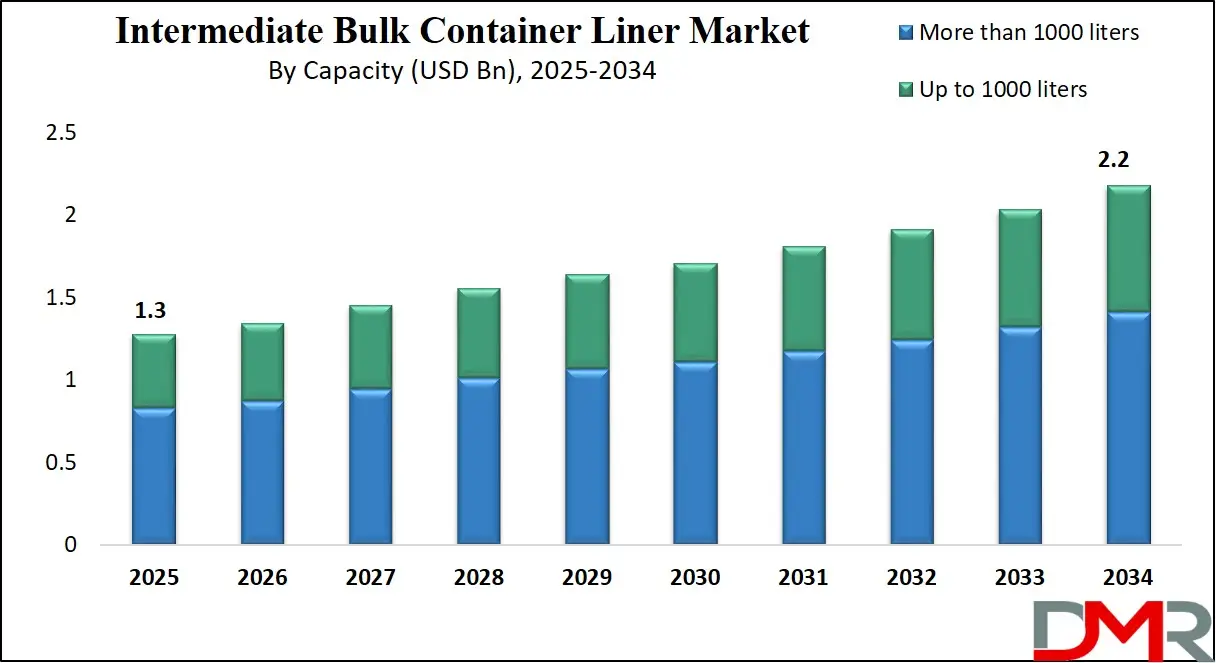
In recent years, several events have shaped the IBC liner market. The COVID-19 pandemic highlighted the need for hygienic packaging, pushing companies to adopt liners for safer handling of medical and food supplies. Global supply chain disruptions also led to increased interest in packaging solutions that are lightweight, disposable, and easier to stock or ship. Manufacturers adapted by increasing local production of liners to meet urgent regional demands.
The US Intermediate Bulk Container Liner Market
The US Intermediate Bulk Container Liner Market size is projected to reach USD 200 million in 2025 at a compound annual growth rate of 5.7% over its forecast period.
The US plays a significant role in the Intermediate Bulk Container (IBC) Liner market due to its strong industrial base and advanced manufacturing practices. With well-established sectors like food and beverage, pharmaceuticals, chemicals, and agriculture, the US drives consistent demand for high-quality and hygienic bulk packaging solutions. The country’s strict safety and environmental regulations also push companies to adopt reliable and compliant liners.
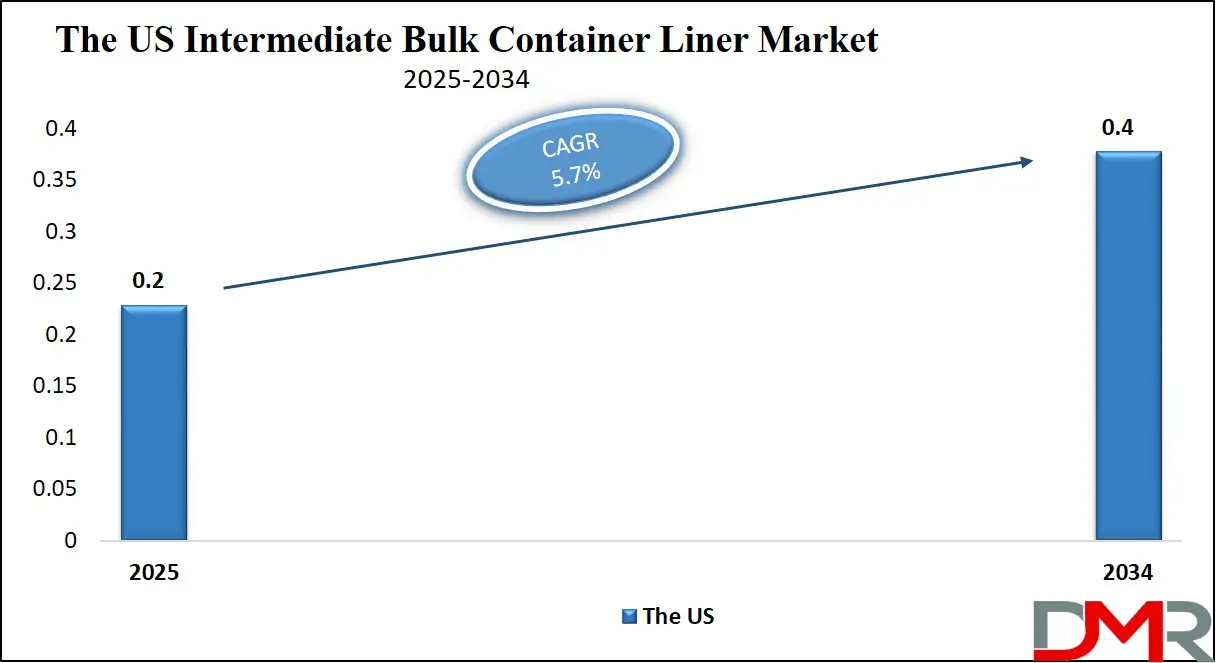
In addition, innovation in sustainable and smart packaging originates largely from US-based research and development centers. The presence of leading liner manufacturers and a mature logistics network further strengthens the US position in the global market. As sustainability and automation gain importance, the US continues to lead in shaping market trends and technological advancements in IBC liner solutions.
Europe Intermediate Bulk Container Liner Market
Europe Intermediate Bulk Container Liner Market size is projected to reach USD 632 million in 2025 at a compound annual growth rate of 5.4% over its forecast period.
Europe holds a vital position in the Intermediate Bulk Container (IBC) Liner market due to its strong emphasis on sustainability, regulatory compliance, and innovation. European industries, especially in food, chemicals, and pharmaceuticals, demand high standards in hygiene and safety, driving the adoption of high-performance IBC liners. The region is a leader in promoting eco-friendly packaging, pushing manufacturers to develop recyclable and biodegradable liners. Europe’s commitment to reducing plastic waste and carbon emissions has led to continuous innovation in liner materials and designs. Additionally, the presence of well-developed infrastructure and strict EU regulations ensures consistent quality and usage of liners across various sectors. Europe's collaborative research environment and focus on green packaging further enhance its influence in shaping the global IBC liner market.
Japan Intermediate Bulk Container Liner Market
Japan Intermediate Bulk Container Liner Market size is projected to reach USD 65 million in 2025 at a compound annual growth rate of 6.9% over its forecast period.
Japan plays a strategic role in the Intermediate Bulk Container (IBC) Liner market due to its focus on precision, quality, and advanced technology. With strong industries in chemicals, electronics, food processing, and pharmaceuticals, Japan relies on efficient and hygienic bulk packaging solutions like IBC liners. The country emphasizes high product safety and cleanliness standards, which align well with the benefits offered by liners. Japan is also at the forefront of material innovation, contributing to the development of durable, multi-layer, and eco-friendly liners. Its commitment to sustainable practices encourages the adoption of recyclable and low-waste packaging. Moreover, Japan's strong logistics infrastructure and export-oriented economy create steady demand for reliable and contamination-free transport solutions, reinforcing its influence in the global IBC liner market.
Intermediate Bulk Container Liner Market: Key Takeaways
- Market Growth: The Intermediate Bulk Container Liner Market size is expected to grow by USD 850 million, at a CAGR of 6.1%, during the forecasted period of 2026 to 2034.
- By Capacity: The more than 1000 liters segment is anticipated to get the majority share of the Intermediate Bulk Container Liner Market in 2025.
- By Application: The Food & beverage segment is expected to get the largest revenue share in 2025 in the Intermediate Bulk Container Liner Market.
- Regional Insight: Europe is expected to hold a 48.6% share of revenue in the Global Intermediate Bulk Container Liner Market in 2025.
- Use Cases: Some of the use cases of Intermediate Bulk Container Liner include the food & beverage industry, chemical industry, and more.
Intermediate Bulk Container Liner Market: Use Cases
- Food & Beverage Industry: IBC liners are widely used to transport liquid and semi-liquid food products like sauces, syrups, oils, and fruit concentrates. They help maintain product purity and hygiene by preventing contamination. The disposable nature of liners also reduces cleaning time and cost.
- Pharmaceutical & Biotechnology: Aseptic IBC liners are used in cleanroom environments for storing and transferring sensitive pharmaceutical ingredients. They ensure sterile conditions and prevent exposure to air, dust, or other contaminants. This is especially important in maintaining regulatory compliance and product safety.
- Chemical Industry: Liners in IBCs help safely transport corrosive, toxic, or volatile chemicals by offering an extra layer of containment. They reduce the risk of leakage or spills and protect the container from damage. This helps companies meet safety standards and avoid costly cleanup.
- Cosmetics & Personal Care: IBC liners are used to store and move bulk creams, gels, lotions, and oils during production. They prevent contamination and allow for easy discharge of thick or viscous materials. This helps maintain product integrity and reduces waste during manufacturing.
Market Dynamic
Driving Factors in the Intermediate Bulk Container Liner Market
Rising Demand for Safe and Hygienic Bulk Packaging
One of the key growth drivers of the Intermediate Bulk Container (IBC) Liner market is the increasing focus on hygiene and safety in bulk packaging, especially across food, pharmaceutical, and chemical industries. As companies handle sensitive and high-value materials, there's a greater need to avoid contamination, leakage, or spoilage during storage and transport. IBC liners provide a protective barrier that ensures product purity while reducing the need for cleaning reusable containers. This not only saves water, time, and chemicals but also supports cleaner, more efficient operations. The growing adoption of ready-to-use, pre-sterilized liners in cleanroom environments further fuels demand. As global health and safety regulations tighten, more businesses are turning to IBC liners as a practical and reliable solution.
Shift Toward Sustainable and Cost-Effective Solutions
Sustainability has become a major factor influencing purchasing decisions in industrial packaging, which is boosting the growth of IBC liners. Traditional packaging methods often require repeated cleaning, use of harsh chemicals, and result in high water consumption. IBC liners, being disposable and sometimes recyclable or biodegradable, offer an eco-friendly alternative. They help extend the lifecycle of containers by preventing direct contact with the contents, thus minimizing wear and tear. Additionally, these liners reduce operational costs by simplifying the logistics and cleanup process. As industries aim to meet environmental goals while staying cost-efficient, IBC liners provide a balanced solution. The shift toward circular packaging practices and reduced carbon footprints continues to drive their adoption across sectors
Restraints in the Intermediate Bulk Container Liner Market
Concerns About Plastic Waste and Environmental Impact
One major restraint for the Intermediate Bulk Container (IBC) Liner market is the growing concern over plastic waste and its impact on the environment. Most liners are made from polyethylene or other synthetic materials, which can be difficult to recycle or dispose of sustainably, especially in regions with poor waste management systems. This creates a challenge for companies that are under pressure to reduce their environmental footprint. Regulatory bodies and consumers are increasingly demanding greener packaging options, and the use of single-use liners may conflict with these sustainability goals. As a result, some industries may hesitate to adopt IBC liners unless more eco-friendly alternatives become widely available and affordable.
High Costs for Specialized and Custom Liners
While IBC liners offer many benefits, the cost of high-performance or customized liners can be a limiting factor for small and medium-sized businesses. Industries like pharmaceuticals or food processing often require sterile, multi-layered, or chemical-resistant liners, which come at a premium price. This added expense may discourage widespread adoption, especially in price-sensitive markets or developing regions. Additionally, companies must consider the cost of training staff to install liners properly and the risk of damage or leakage if the liner is not used correctly. For businesses with tight budgets or lower production volumes, the cost of liners may outweigh the convenience they offer.
Opportunities in the Intermediate Bulk Container Liner Market
Growth in Emerging Economies and Industrial Expansion
Rapid industrialization in emerging economies presents a strong opportunity for the Intermediate Bulk Container (IBC) Liner market. Countries in Asia, Latin America, and Africa are experiencing growth in sectors like food processing, chemicals, pharmaceuticals, and agriculture, all of which require safe and efficient bulk packaging solutions. As these industries expand, the need for hygienic, cost-effective, and easy-to-use transport systems will increase. IBC liners offer a simple way to handle bulk materials without investing heavily in container cleaning infrastructure. As awareness about modern packaging and hygiene standards spreads, the demand for IBC liners is expected to grow steadily in these developing regions, offering significant market potential.
Innovation in Eco-Friendly and Smart Packaging Solutions
The rise in focus on global sustainability opens doors for innovation in environmentally friendly IBC liners. Manufacturers are now investing in the development of biodegradable, compostable, or fully recyclable liner materials to address environmental concerns. This shift not only supports compliance with green regulations but also aligns with corporate sustainability goals. There is also a growing opportunity to integrate smart packaging technologies, such as sensors or tracking tags, into liners to monitor product integrity during transport. These advancements can offer added value to industries dealing with sensitive goods, like pharmaceuticals and food, and position IBC liners as intelligent, future-ready packaging solutions in global supply chains.
Trends in the Intermediate Bulk Container Liner Market
Adoption of Sustainable and Eco-Friendly Materials
A major trend in the IBC liner market is the growing shift toward sustainability. Manufacturers are now designing liners using recyclable, biodegradable, or renewable materials to reduce environmental impact. This change is being driven by rising awareness about plastic pollution and global pressure to adopt greener practices. Companies across food, chemical, and pharmaceutical industries are showing a preference for liners that support eco-friendly operations. In addition, some are focusing on lightweight designs that reduce shipping emissions. As more businesses aim to meet environmental targets, demand for sustainable liners is steadily increasing. This trend is expected to continue as regulations become stricter and end-users seek more responsible packaging options.
Integration of Smart and Automated Handling Solutions
Another key trend in the market is the integration of smart technologies and automation in IBC liner usage. Many industries are now looking for liners that are compatible with automated filling and discharge systems, which help improve efficiency and reduce human errors. Advanced liners are also being developed with features that support aseptic processing or can withstand sterilization, making them suitable for pharmaceutical and biotech use. Additionally, there is growing interest in using sensor-enabled liners that can monitor temperature, pressure, or contamination levels during transport. These innovations are helping industries improve supply chain control, reduce waste, and enhance product safety across long-distance shipments.
Impact of Artificial Intelligence in Intermediate Bulk Container Liner Market
Artificial Intelligence is gradually influencing the Intermediate Bulk Container (IBC) liner market by streamlining manufacturing processes, enhancing quality control, and optimizing supply chain operations. AI-powered systems are being used to monitor production lines in real-time, detect defects or inconsistencies in liner materials, and ensure consistent quality. Through predictive maintenance, AI helps prevent equipment failures, reducing downtime and improving overall productivity. This is particularly important in industries like chemicals, food and beverage, and pharmaceuticals, where contamination or leakage can have serious consequences. By improving precision and efficiency in liner production, AI is helping manufacturers meet strict safety and regulatory standards while reducing waste and operational costs.
In addition to manufacturing, AI is transforming how IBC liners are managed, distributed, and utilized across logistics networks. Advanced analytics and machine learning models can forecast demand, optimize inventory levels, and streamline delivery schedules. AI also enables smarter packaging and usage tracking, ensuring that liners are used efficiently and replaced at the right time to maintain safety and performance. For industries handling hazardous or sensitive materials, AI-driven sensors and IoT integration in containers can monitor environmental conditions such as temperature, pressure, or contamination risks, allowing for real-time alerts and response. While the adoption of AI in this niche market is still emerging, its impact is becoming increasingly evident in improving reliability, compliance, and sustainability. As the demand for safer and more efficient bulk packaging grows, AI is set to play a critical role in advancing innovation and operational excellence within the IBC liner industry.
Research Scope and Analysis
By Capacity Analysis
More than 1000 liters capacity segment is expected to be leading in 2025 with a share of 64.8%, playing a key role in driving the growth of the Intermediate Bulk Container (IBC) Liner market. This segment is widely preferred for transporting and storing large volumes of liquids and semi-liquids across long distances. Industries such as chemicals, food processing, and pharmaceuticals rely on high-capacity containers to improve logistics efficiency and reduce handling time. Liners used in these larger containers help maintain product purity, reduce contamination risks, and cut down on cleaning costs. As bulk trade and global shipping continue to expand, the demand for over 1000-liter liners is rising due to their ability to support large-scale operations. Their use also supports sustainable practices by enabling the reuse of outer containers while only replacing the liner. This makes them a practical and cost-effective solution, further strengthening their market position over the forecast period.
With strong adoption across various industries, the up to 1000 liters capacity segment is showing significant growth over the forecast period in the Intermediate Bulk Container (IBC) Liner market. This segment is ideal for smaller-scale transport and storage needs, offering flexibility and ease of handling for products like oils, powders, and food ingredients. It is especially popular among medium-sized businesses and in local distribution networks where space and handling equipment may be limited. Liners in this category help ensure product safety, minimize cleaning efforts, and improve turnaround time. Their compact size and efficiency make them a preferred choice for short-distance shipping and internal transfers. As demand for clean, efficient, and economical packaging continues to grow, this segment is becoming more important in industries seeking practical bulk handling solutions without the need for high-capacity infrastructure.
By Application Analysis
The food & beverage application segment is expected to be leading in 2025 with a share of 70.8%, playing a major role in the growth of the Intermediate Bulk Container (IBC) Liner market. This segment depends heavily on hygienic and contamination-free packaging for the safe transport and storage of liquid and semi-liquid products like juices, sauces, oils, and dairy items. IBC liners help maintain product quality by acting as a protective barrier, reducing exposure to air, moisture, or foreign particles. They also eliminate the need for time-consuming cleaning of containers, making operations faster and more cost-efficient. With strict food safety regulations and growing demand for processed food and beverages, companies are investing in reliable packaging solutions like IBC liners. The rising need for clean, efficient, and large-volume transport solutions in the food sector continues to push demand, making this segment a key driver of market growth during the forecast period.
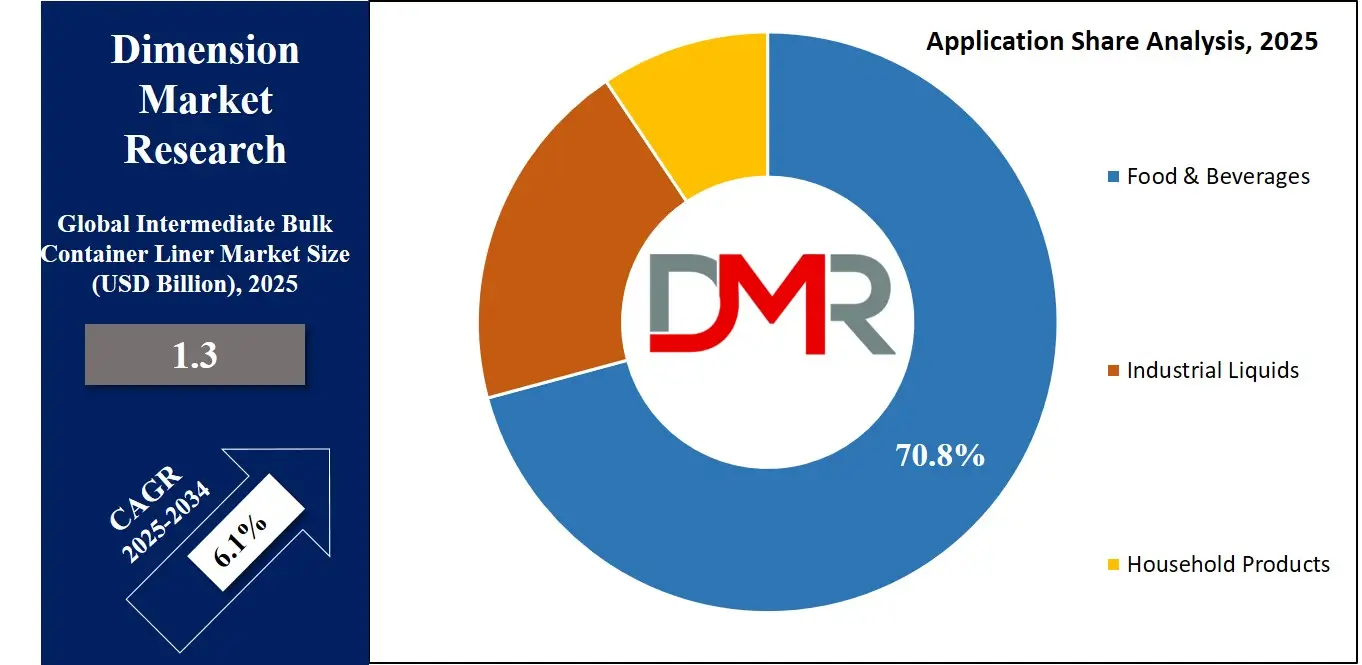
Further, the industrial liquid segment is witnessing significant growth over the forecast period in the Intermediate Bulk Container (IBC) Liner market due to increasing use in sectors like chemicals, lubricants, paints, and cleaning agents. These industries require safe, leak-proof, and durable packaging solutions to handle corrosive or sensitive materials during bulk transport and storage. IBC liners provide an added layer of protection that helps prevent leaks, reduce contamination, and minimize environmental risk. They also minimize the need for deep cleaning of containers, saving time and resources. As industries continue to expand production and export of liquid-based products, demand for high-quality liners that ensure safe handling is growing. This segment is also benefiting from the rise in global trade, stricter safety rules, and the push for cleaner, more efficient bulk handling methods across industrial applications.
The Intermediate Bulk Container Liner Market Report is segmented on the basis of the following:
By Capacity
- Up to 1000 Liters
- More than 1000 Liters
By Application
- Food & Beverages
- Industrial Liquids
- Household Products
Regional Analysis
Leading Region in the Intermediate Bulk Container Liner Market
Europe, leading in 2025 with a share of 48.6%, plays a major role in the growth of the Intermediate Bulk Container (IBC) Liner market due to its strong focus on sustainability, hygiene, and advanced packaging standards. The region’s strict environmental regulations and commitment to reducing plastic waste have encouraged industries to adopt eco-friendly and recyclable IBC liners.
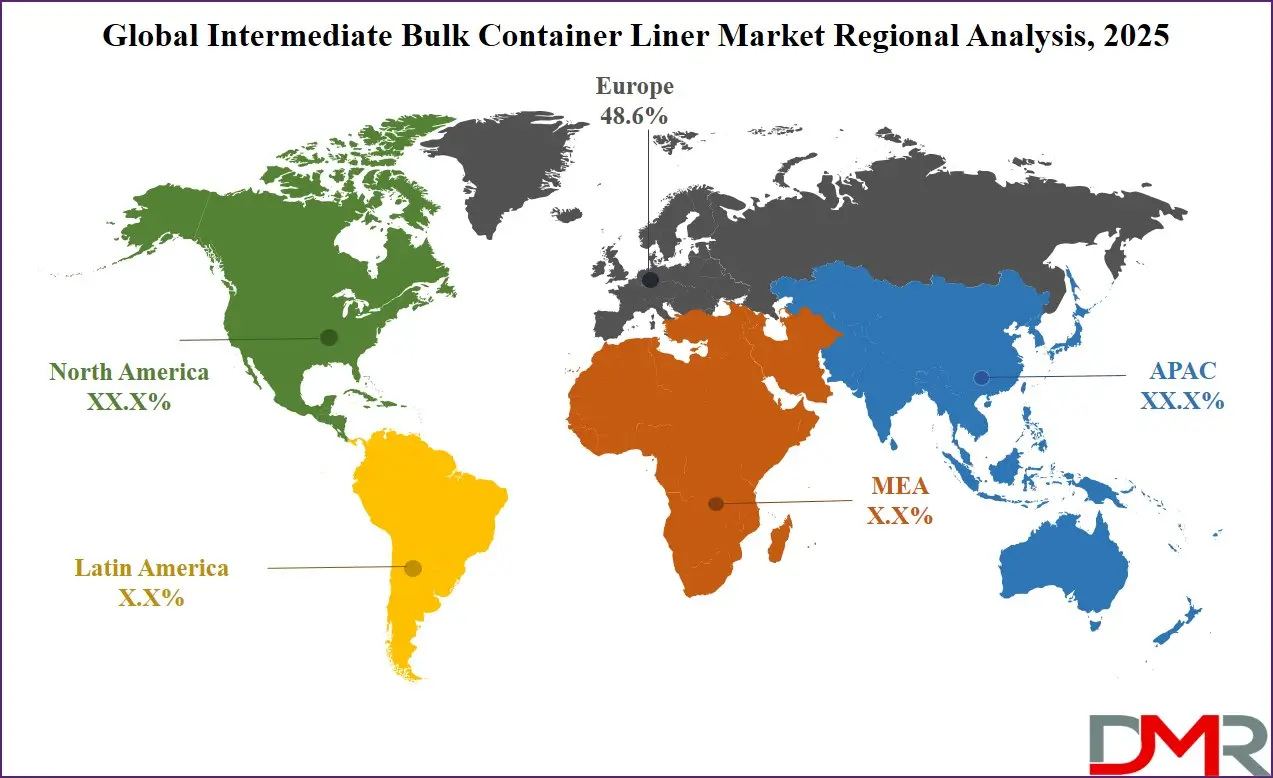
Sectors like food and beverage, pharmaceuticals, and chemicals in Europe rely heavily on safe and efficient bulk packaging solutions, which has increased the use of high-performance liners. Ongoing innovation in liner materials, supported by research and development centers across the region, has further fueled market growth. Many European companies are choosing IBC liners to meet clean packaging requirements, reduce cleaning costs, and support green initiatives. With growing emphasis on operational safety, product purity, and regulatory compliance, Europe continues to influence global trends and demand patterns in the IBC liner market, making it a strong contributor to the market's development in the current year.
Fastest Growing Region in the Intermediate Bulk Container Liner Market
Asia Pacific is showing significant growth over the forecast period in the Intermediate Bulk Container (IBC) Liner market, driven by rapid industrial expansion and rising demand for cost-effective bulk packaging. The region's strong presence in industries like chemicals, food processing, agriculture, and pharmaceuticals is boosting the need for IBC liners that ensure safe, hygienic, and efficient transport. As manufacturing and exports increase, companies are turning to IBC liners to improve product protection and reduce container cleaning time. Growing awareness about sustainable packaging, along with rising investments in logistics and infrastructure, is further supporting market expansion. Countries like China, India, and Japan are becoming key contributors to this growing demand.
By Region
North America
Europe
- Germany
- The U.K.
- France
- Italy
- Russia
- Spain
- Benelux
- Nordic
- Rest of Europe
Asia-Pacific
- China
- Japan
- South Korea
- India
- ANZ
- ASEAN
- Rest of Asia-Pacific
Latin America
- Brazil
- Mexico
- Argentina
- Colombia
- Rest of Latin America
Middle East & Africa
- Saudi Arabia
- UAE
- South Africa
- Israel
- Egypt
- Rest of MEA
Competitive Landscape
The competitive landscape of the Intermediate Bulk Container (IBC) Liner market is shaped by innovation, customization, and quality. Many players in the market focus on developing liners that meet specific industry needs, such as food safety, chemical resistance, and pharmaceutical-grade hygiene. Companies compete by offering durable, leak-proof, and easy-to-install liners, often made with advanced materials or multi-layer protection. The market also sees competition in pricing, sustainability efforts, and customer support. As demand grows in industries like agriculture, chemicals, and healthcare, manufacturers strive to deliver efficient, recyclable, and cost-effective solutions. Global expansion, partnerships, and strong distribution networks are key strategies. Innovation in design, improved barrier properties, and eco-friendly options are helping companies stand out in this competitive environment.
Some of the prominent players in the global Intermediate Bulk Container Liner are:
- Amcor plc
- Sealed Air Corporation
- CDF Corporation
- Arena Products, Inc.
- Qbig Packaging B.V.
- Nittel GmbH & Co. KG
- LC Packaging International B.V.
- Brambles Industries Limited (CHEP)
- Berry Global, Inc.
- Plastipak Holdings, Inc.
- Composite Containers LLC
- Rishi FIBC Solutions Pvt. Ltd
- Scholle IPN
- Liquibox
- ILC Dover LP
- Greif Inc.
- Smurfit Kappa
- Steripac Asia
- Peak Packaging Ltd.
- Paper Systems Inc.
- Other Key Players
Recent Developments
- In June 2025, The HOYER Group acquired the IBC totes logistics operations of French company Trans Modal Partenaires (TMP), including all IBC containers managed in France and Spain, along with related services. This move strengthens HOYER’s presence in the food and cosmetics sectors and expands its market share in both countries. TMP’s founder, Bernard Miquel, expressed confidence in HOYER as a trusted successor. HOYER’s IBC services include fleet management, rental, transport, cleaning, maintenance, and repair, enhancing its offerings across the region.
- In May 2025, Chemco Group and Kandoi Group have formed a joint venture to establish two manufacturing facilities in Vapi and Dahej, Gujarat, to produce FIBC (Flexible Intermediate Bulk Container) bags from recycled PET (rPET). With an investment of INR 450 crore, the plants will feature a closed-loop system covering PET bottle collection to final bag production, ensuring quality and traceability. Designed to recycle over 10 million PET bottles daily, the facilities will run entirely on renewable energy, offering a sustainable packaging alternative.
- In September 2024, Greif opened a new intermediate bulk container (IBC) manufacturing facility in Pasir Gudang, Johor, Malaysia, which aims to strengthen the company’s production capacity in the region while supporting the local economy by generating employment opportunities. The new facility marks a strategic move to meet growing demand for IBC solutions in Southeast Asia and reflects Greif’s commitment to enhancing its global manufacturing network and delivering efficient packaging solutions.
Report Details
| Report Characteristics |
| Market Size (2025) |
USD 1.3 Bn |
| Forecast Value (2034) |
USD 2.2 Bn |
| CAGR (2025–2034) |
6.1% |
| Historical Data |
2019 – 2024 |
| The US Market Size (2025) |
USD 0.2 Bn |
| Forecast Data |
2025 – 2033 |
| Base Year |
2024 |
| Estimate Year |
2025 |
| Report Coverage |
Market Revenue Estimation, Market Dynamics, Competitive Landscape, Growth Factors, etc. |
| Segments Covered |
By Capacity (Up to 1000 Liters and More than 1000 Liters), By Application (Food & Beverages, Industrial Liquids, and Household Products) |
| Regional Coverage |
North America – US, Canada; Europe – Germany, UK, France, Russia, Spain, Italy, Benelux, Nordic, Rest of Europe; Asia-Pacific – China, Japan, South Korea, India, ANZ, ASEAN, Rest of APAC; Latin America – Brazil, Mexico, Argentina, Colombia, Rest of Latin America; Middle East & Africa – Saudi Arabia, UAE, South Africa, Turkey, Egypt, Israel, Rest of MEA |
| Prominent Players |
Amcor plc, Sealed Air Corporation, CDF Corporation, Arena Products, Inc., Qbig Packaging B.V., Nittel GmbH & Co. KG, LC Packaging International B.V., Brambles Industries Limited (CHEP), Berry Global, Inc., Plastipak Holdings, Inc., Composite Containers LLC, Rishi FIBC Solutions Pvt. Ltd, Scholle IPN, Liquibox, ILC Dover LP, Greif Inc., Smurfit Kappa, Steripac Asia, Peak Packaging Ltd., Paper Systems Inc, and Other Key Players |
| Purchase Options |
We have three licenses to opt for: Single User License (Limited to 1 user), Multi-User License (Up to 5 Users), and Corporate Use License (Unlimited User) along with free report customization equivalent to 0 analyst working days, 3 analysts working days, and 5 analysts working days respectively. |
Frequently Asked Questions
The Global Intermediate Bulk Container Liner Market size is expected to reach a value of USD 1.3 billion in 2025 and is expected to reach USD 2.2 billion by the end of 2034.
Europe is expected to have the largest market share in the Global Intermediate Bulk Container Liner Market, with a share of about 48.6% in 2025.
The Intermediate Bulk Container Liner Market in the US is expected to reach USD 0.2 billion in 2025.
Some of the major key players in the Global Intermediate Bulk Container Liner Market are Thermo Fisher Scientific, Merck KGaA, Danaher, and others
The market is growing at a CAGR of 6.1 percent over the forecasted period.